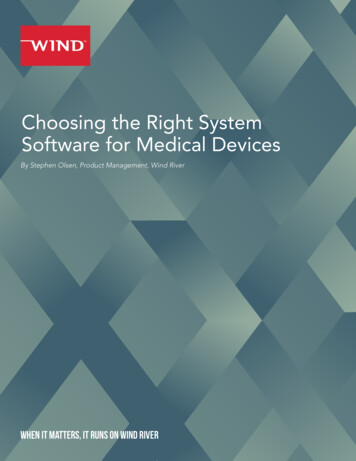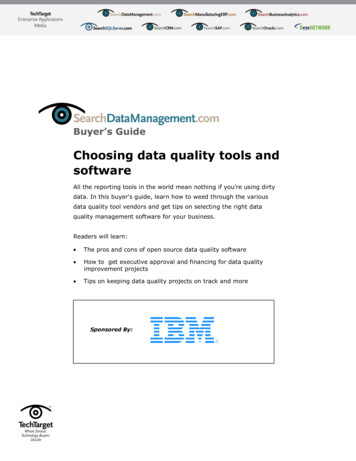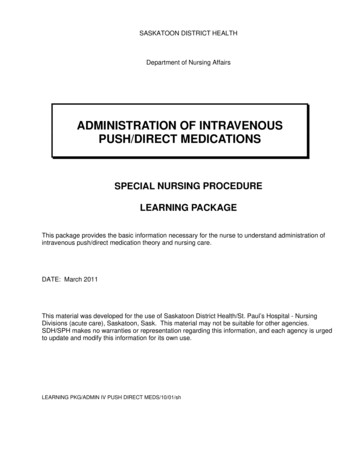
Transcription
AN INTEL COMPANYChoosing the Right SystemSoftware for Medical DevicesBy Stephen Olsen, Product Management, Wind RiverWHEN IT MATTERS, IT RUNS ON WIND RIVER
CHOOSING THE RIGHT SYSTEM SOFTWARE FOR MEDICAL DEVICESEXECUTIVE SUMMARYFinding the right software for the design of medical devices is critical, as there islittle room for error. Developers have many choices to make, from whether to use a“roll-your-own” solution or a commercial off-the-shelf product to whether to employa real-time operating system or a general purpose operating system such as Linux orAndroid. There is no optimal solution for all devices, but understanding the parametersof the application and its interaction with the target hardware will help developersnarrow their search. This article explores the breadth of considerations that are essentialin making the best choice.TABLE OF CONTENTSExecutive Summary. . . . . . . . . . . . . . . . . . . . . . . . . . . . . . . . . . . . . . . . . . . . . . . . . . . . . . . . . . . 2Starting Point: Design Considerations. . . . . . . . . . . . . . . . . . . . . . . . . . . . . . . . . . . . . . . . . . . . 3Trends Impacting Medical Device Design. . . . . . . . . . . . . . . . . . . . . . . . . . . . . . . . . . . . . . . . . 4System Requirements for Medical Devices: An Example . . . . . . . . . . . . . . . . . . . . . . . . . . . . 4Additional System Software Considerations. . . . . . . . . . . . . . . . . . . . . . . . . . . . . . . . . . . . . . . 5Commercial vs. Open Source: Decision Criteria. . . . . . . . . . . . . . . . . . . . . . . . . . . . . . . . . . . . 6Conclusion. . . . . . . . . . . . . . . . . . . . . . . . . . . . . . . . . . . . . . . . . . . . . . . . . . . . . . . . . . . . . . . . . . 72 White Paper
CHOOSING THE RIGHT SYSTEM SOFTWARE FOR MEDICAL DEVICESSTARTING POINT: DESIGN CONSIDERATIONSThe answers to these use-case questions will inform and guideSeveral years ago, I had Lasik eye surgery. While the procedurethe system software evaluation and decision criteria. For example,took less than one minute per eye, I found myself wondering aboutwhen systems are small and implantable, the need for real timethe software that was used to control the laser. For my procedure Iis usually negligible and the software associated with thesehad a choice between a manually controlled laser or an automaticdevices may be relegated to monitoring a small set of sensors andtracking laser. I weighed the pros and cons of each scenario, andadministering some small amount of therapy. In a maintenanceeventually I opted for the more complex automatic tracking laser.or data collection mode, the device may receive a radio signalBut was it the right choice? What would have happened hadfrom outside the body, and this could be done with a low-powerI chosen the laser with manual tracking? My sight is better thanmicrocontroller that can be built with a simple state machine.20/20 now without glasses, but the surgery got me thinking aboutOn the other end of the spectrum, systems that employ a generalthe system software that goes into such medical devices.purpose operating system, such as Linux or Android, are typicallyThis example underscores the point that any discussion aboutnot concerned with memory and physical size constraints. Imagingsoftware for medical devices should begin with one overarchingconsideration: Medical devices directly impact human lives. Thatmeans every decision that involves the specifications of the devicealso impacts human lives. That said, modern medical devicescome in all shapes and sizes—from very large, elaborate radiationmachines to small, implanted pacemakers that are batteryoperated—and they vary greatly in the criticality of their intendedfunctions. Therefore the first specific consideration in selecting theright system software should be the intended use case.systems that are administering a signal into the body and producingan image from that signal employ a large signal-processingalgorithm that needs to be processed in near real time—forexample, an ultrasound that is imaging a mother’s womb. This isnear real-time because the response can be one second delayedfrom the actual signal, but it must closely correlate to the scan,as the operator will use this feedback to guide the device to giveparents peace of mind.The majority of portable electronic medical devices fall somewhereHow will the device be used? Will it be used primarily by ain between these two examples. These systems are somewhathealthcare provider, by the patient at home, or both? Will itmemory-constrained, battery-operated, and connected devicescollect and store data? Will there be special service modes thatthat may have real-time constraints as well. The combination ofallow access only to a trained technician? Will it be wall powered,such attributes almost necessitates a real-time operating systembattery powered, or both? Are there charging cycles? Is the deviceover a general-purpose operating system.usable when it’s charging?3 White Paper
CHOOSING THE RIGHT SYSTEM SOFTWARE FOR MEDICAL DEVICESTRENDS IMPACTING MEDICAL DEVICE DESIGNFurther, the average lifespan of both men and women isIn addition to the intended use case, it is important to considerincreasing in many countries. With more people living longer,some of the meta-trends in the medical industry. One such trend isdiseases associated with aging are far more prevalent. We needthat an increasingly broad range of professionals is using a varietyto find innovative and cost-effective ways to monitor, diagnose,of devices to treat their patients. As medical devices become moreand treat these maladies. Embedded medical devices need toubiquitous, with both professionals and non-professionals usingsafely communicate information from device to device, device tothem—such as in-home care or nursing home situations—thenetwork, or even device to a server in the cloud. To go even furtherquestion is not only whether these devices are capable of doingwould be to utilize fluid computing by allowing an application totheir job but, even more importantly, whether anyone with a basicexecute where it is best applied, either in the cloud or on the edge,understanding can operate such a device. Is the device easy to usedepending on the use case. All the while, we must ensure thatin an emergency situation when seconds matter? What happens ifcommunications and data that flow between the device, the edge,the device fails?and the cloud are safe and kept in compliance with the HealthWhen you combine this trend with the skyrocketing costs ofhealthcare, it’s clear the onus is on the embedded softwaredeveloper to design a complete solution that goes beyond basicdevice functionality. There’s a mandate to minimize cost per capitaof each person’s healthcare by looking at ways to streamlinediagnoses, add innovative ways to administer preventive care,and in the process find new technologies to minimize the costs ofthese devices as they become more pervasive in our society.Insurance Portability and Accountability Act of 1996 (HIPAA).SYSTEM REQUIREMENTS FOR MEDICAL DEVICES:AN EXAMPLELooking across the landscape of medical devices in use today,there is a wide range of applications—but regardless of size,shape, and use case, all medical devices share the same need forsystem reliability, ease of use, and fault tolerance.Let’s take a look at the system requirements of one device as an CapitationCost Containment Insurance Approval Outpatient Careexample: the wall-mounted defibrillator. Defibrillators are thequiet sentinels seen in hallways and rooms wherever there arelarge numbers of people. These devices are involved in both lifealtering and lifesaving situations. They are often used by innocent Improved DiagnosesQuality of Care Preventive Care Better Technology More Medical NeedsAging Populationbystanders who are not familiar with how the device works—andin many cases people are faced with learning to use it quicklybecause every second matters. The basic system requirements ofa defibrillator include:1. A long-term shelf life: It may be wall powered or completely Frequent Monitoringbattery operated, but it must work within a moment’s notice to Self-Diagnosismonitor a patient’s vitals and, if needed, deliver the necessarytreatment.2. An easy-to-use human–machine interface (HMI): The HMIPrivacy HIPAA Electronic Medical Recordsmust be so simple that anyone who can read or hear thelanguage can use it.3. Secure and stable communications: Communications areFigure 1: Key healthcare trends and issuesessential to enable the defibrillator to self-diagnose.4. A multi-CPU design: The design should help ensure efficientoperating performance along with taking advantage of powermanagement opportunities.4 White Paper
CHOOSING THE RIGHT SYSTEM SOFTWARE FOR MEDICAL DEVICESNow let’s look at these requirements in a little more detail:Long-Term Shelf LifeSecure and Stable CommunicationsFor medical devices that can actually save a person’s life, the needAfter the episode, the unit must phone home to give the datafor long-term shelf life is critical. If it is battery operated, the devicewill need to last its entire useful life without being recharged. Thismeans the system software must be designed to minimize theto the administrator who can relay the pertinent data in a HIPAAcompliant way to the patient’s doctor for further review. Then itmust give instructions to the user on how to restore the system touse of the battery. One way to do this is to use two processors: aits proper place so it is ready for the next event.smaller processor, a type of “sanity check” processor, is used toMulti-CPU System Designkeep the system alive, and a larger processor handles all the realtime events as they happen.The use of two cores is recommended, one to monitor the healthof the device on a daily or weekly basis and the other to beThe smaller processor can be used to wake up the device oncecapable of higher power, higher functionality to drive the interface,a day or once a week to do some evaluation of the hardwareassessment of the patient data once the probes are attached, andand ensure its readiness. It should also be able to report back toshocking the patient.the administrator so that those monitoring the device know it’sfunctioning normally or, in the event of a failure, can arrange aservice call to fix a perceived malfunction.In this case, the system must meet some communication needs,which involves the use of a GSM (Global System for Mobilecommunications) protocol stack, and during the event a muchOnce the device is activated, it must wake up the main CPU, thehigher capacity CPU, to determine if a shock is warranted. Because“event processor.” Among the many responsibilities of this coreof these needs, the use of a simple “round-robin” scheduler isis to be capable of delivering an intuitive HMI. This core is alsoexceeded and the use of either a real-time operating system or aresponsible for monitoring the patient’s vitals and delivering thegeneral purpose operating system is warranted.electrical shock the patient might need—all this while minimizingthe use of power for the device’s full lifecycle.The operating system decision depends on several factors. First,are there fast boot and low power requirements? In this deviceEasy-to-Understand HMIevery second counts. Minimizing the amount of software to runIn the event a patient needs the defibrillator, the device wakes upwould warrant a real-time operating system, which is typicallyand instructs the first responder on how to use the device. Thisshould be done both audibly, via a speaker, as well as visually, viasome type of graphical user interface (GUI). It is important notto overcomplicate the GUI, as studies have shown that a simple,intuitive interface with minimal options will be used by a laymanmore quickly than an interface that is more complicated.A clear and easy-to-use GUI involves instructing the user tocorrectly attach the pads on the patient. Once they are placedmany times smaller than a general-purpose operating system.A smaller footprint means smaller RAM requirements and hencesmaller power use needs. A smaller footprint also means lesscode to run. Since time is of the essence, a real-time operatingsystem is warranted. If a medical device was used in a nonemergency situation, a general-purpose operating system wouldbe acceptable and the availability of middleware could be anadvantage.on the patient, the device must quickly determine whether theADDITIONAL SYSTEM SOFTWARE CONSIDERATIONSpatient needs a shock. If so, then it charges the capacitors to theBeyond the four key considerations discussed above, medicalcorrect dosage and instructs the user to back off the patient sothat they can be shocked without shocking any bystanders, againin easy-to-understand instructions.5 White Paperdevice designers should take into account a broad range ofadditional system software attributes, including:
CHOOSING THE RIGHT SYSTEM SOFTWARE FOR MEDICAL DEVICESModularity: Medical devices need to adapt to changing needs inRich user interface: With customer experience and the userthe network, so the operating system must be built on a modular,interface becoming key differentiating features for medicalupgradeable, future-proof architecture that separates the coredevices, powerful yet easy-to-use human–machine interactionkernel from middleware, protocols, applications, and othercapabilities are becoming a must for system software, includingpackages. It should provide a stable core so that middleware, newquality 2-D and 3-D graphics engines, support for multipleprotocols, and other packages can be added or upgraded withoutmonitors and touch screens, and rich graphic design tools.changing the core. This modularity will also help manufacturers ofmedical devices better differentiate their products and maintainCOMMERCIAL VS. OPEN SOURCE: DECISION CRITERIAthem competitively over longer periods of time.The availability and use of both commercial and open sourceScalability: With the proliferation of medical devices and classesof devices—ranging from small form factor, single-applicationdevices to large-scale, complex, multi-application systems—thescalability of the system software is of utmost importance. Asingle RTOS that can scale to meet the unique memory footprint,development options are pervasive among medical devicemanufacturers. Each has unique advantages and trade-offs,but the choice typically comes down to the completeness andsophistication of commercial offerings versus the low cost andubiquity of open source software.functionality, and processing power requirements of multipleCommercial offerings are now available specifically for the creationproduct classes can help manufacturers of embedded systemsof medical devices. For example, VxWorks Plus delivers all of theincrease the return on their operating system investment, cutrich feature set of VxWorks real-time operating system (RTOS), withdevelopment costs by leveraging the economies of scope, andan additional collection of advanced middleware and protocolsreduce time-to-market.for security, safety, networking, connectivity, device manageability,Security: Medical device system software needs to supportsecurity features not only to protect against malware andunwanted or rogue applications but also to deliver secure datastorage and transmission and tamper-proof designs. OS-levelsupport for these features is critical, since adding them at the useror application level is ineffective, expensive, and risky. And, sincesecurity threats are always changing, the system software needsuser interface (UI), and graphics that customers need to createthe most demanding devices for the Internet of Things (IoT). Thisincludes features that help meet the requirements of medicaldevice manufacturers (for up to Class III medical equipment).Additionally, it includes a compliance package to facilitate approvals from the U.S. Food and Drug Administration (FDA) and otherregulatory agencies worldwide.to support the secure upgrade, download, and authentication ofOpen source software options, such as the Linux operating system,applications to help keep devices secure going forward.are also popular for a number of good reasons:Safety: Clearly, safety is paramount for medical devices because Distributions are free and can be modified and redistributedthey could endanger life and malfunctions could cause injury ordeath—but not all medical device applications are equally lifeunder the GNU General Public License (GPL). Thousands of developers have adopted Linux, making it easiercritical. When evaluating system software, look for features andto find developers who use it frequently and know it intimately.capabilities that allow multiple applications with different levels of Linux runs on virtually any processor and is supported by virtu-criticality to run on the same hardware platform.Connectivity: Medical devices are increasingly connected topublic networks for a wide range of applications. This meansthe system software may need to support a wide range ofcommunications standards and protocols such as CAN, Bluetooth,Continua, IEEE 802.15.4, Wi-Fi, and Ethernet—and deliver highperformance networking capabilities out of the box. In additionto these capabilities, look for system software that can helpretrofit existing devices with the required connectivity options sothey can be brought online without reworking the core of theirembedded software.6 White Paperally all major hardware manufacturers. The maturity of Linux has made it a practical choice in medicaldevice development. Linux is feature-rich in tools, management, security, andgraphics—important for medical device screens that requireclarity and readability—and has a large ecosystem of board andsoftware providers.
CHOOSING THE RIGHT SYSTEM SOFTWARE FOR MEDICAL DEVICESFor all its advantages, however, using open source software suchas Linux in a medical device also poses a number of challenges.For example, medical device manufacturers must follow severalFDA guidance documents, and the medical device softwarestandard IEC 62304 is now recognized or required in mostjurisdictions. In addition, medical devices marketed in the UnitedStates are regulated by the Center for Device and RadiologicalHealth (CDRH), a branch of the FDA. The FDA makes it clear thatthe burden of ensuring safe and reliable performance does notend with product launch. When evaluating operating systems,planning for bug fixes and security updates for the entire lifecycleof the product is recommended.CONCLUSIONIt is incumbent on no organization, vendor, or individual to toutany particular system software product or approach as superior toall others for medical device makers. Needs and requirements varygreatly, as do features, functions, and capabilities. It is important,however, to evaluate the full range of considerations beforemaking the selection. After all, human lives are at stake in thecreation and use of medical devices.One day we may find ourselves at the mercy of some strangertrying to use a defibrillator that we designed. Do you trust yourown design to work every time—especially when it’s needed atthe most critical time? If we design with this question in mind, thedevices we create will work each and every time. When you’veimproved the quality of life for everyone who comes into contactwith the medical device you designed—that’s a job well done.Wind River is a global leader in delivering software for the Internet of Things. The company’s technology is found in more than 2 billion devices, backed by world-class professional services andcustomer support. Wind River delivers the software and expertise that enable the innovation and deployment of safe, secure, and reliable intelligent systems. 2018 Wind River Systems, Inc. The Wind River logo is a trademark of Wind River Systems, Inc., and Wind River and VxWorks are registered trademarks of Wind River Systems, Inc. Rev. 02/2018
the system software that goes into such medical devices . This example underscores the point that any discussion about software for medical devices should begin with one overarching consideration: Medical devices directly impact human lives . That means every decision that involves the specifications of the device also impacts human lives .











